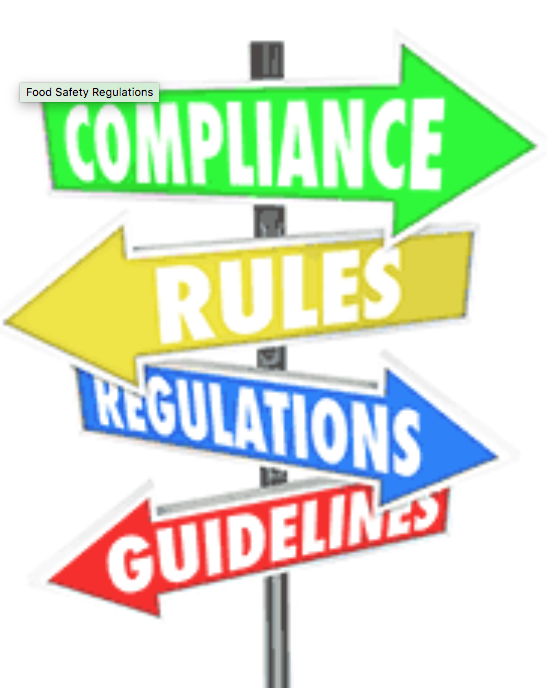Food Safety Regulations
Modern day food safety regulations were developed on sound scientific principles to protect consumers from incidents of foodborne illness and death. In the modern information age of 24-hour news cycles and social media, expectations have changed drastically from 100 years ago. Consumers are now aware of food safety incidents the minute they happen, sometimes even before the implicated companies are informed.
Food represents one of the largest globally traded commodities and can pose a major safety risk if not controlled. With globalization, the supply chain must be carefully monitored to ensure imports meet food safety regulations and are free from tampering.
Governments around the world are acting swiftly to update and modernize their legislation. Adopting industry-leading best practices, food safety regulations are increasingly outcome-based and transparent. Governments are also seeking to harmonize their food safety regulations across borders to keep the flow of goods moving seamlessly through the supply chain.
Each government has a different interpretation of what constitutes risk for its citizens. But in recent years, the United States and Canada have made sweeping changes to food safety regulations with the Food Safety Modernization Act and the Safe Food for Canadians Act. From Germany to New Zealand to China, governments have a vested interest in ensuring that their food products are safe to eat and comply with food safety regulations.
Information on recent food safety regulations and regulatory bodies can be found below. Click on the links for more details on domestic and foreign supply requirements:
United States
The Food Safety Modernization Act (FSMA): Published by the United States’ Food and Drug Administration (FDA), the FSMA addresses how food safety is regulated. It allows the FDA sweeping powers to monitor the private sector in regards to food safety issues.
Canada
The Safe Food for Canadians Act (SFCA): The SFCA was published by the Canadian Food Inspection Agency (CFIA). It strengthens food safety rules, provides new ways for food inspectors and laboratories develop to operate effectively, and keep consumers updated on food safety issues.
Europe
The European Food Safety Authority (EFSA): The EFSA is the European Union (EU) risk assessment body regarding food and feed safety. In close collaboration with national authorities and in open consultation with its stakeholders, EFSA provides independent scientific advice and clear communication on existing and emerging risks. EFSA is an independent European agency funded by the EU budget that operates separately from the European Commission, European Parliament and EU Member States.
Australia and New Zealand
Food Standards Australia New Zealand: A bi-national government agency, it develops and administers the Australia New Zealand Food Standards Code. The Code lists requirements for foods including additives, food safety, labelling and Genetically Modified foods. Enforcement and interpretation of the Code is the responsibility of state and territory departments and food agencies within Australia and New Zealand.
Argentina
The National Food Safety and Quality Service/ Servicio Nacional de Sanidad y Calidad Agroalimentaria (SENASA): SENASA is an independent agency of the Argentine government charged with surveillance, regulation and certification of products of animal and plant origin. The agency is in charge of the prevention, eradication and control of diseases and plagues. SENASA formally comes under the Secretariat of Agriculture, Livestock, Fishing and Food, a division of the Ministry of Economy.
Brazil
Numerous agencies and Ministries share jurisdiction for ensuring the safety of the Brazilian food supply. The Ministry of Agriculture, Livestock, and Food Supply (MAPA) and the Ministry of Health (MS) – through its National Agency of Sanitary Surveillance (ANVISA) – are the primary regulators of agricultural products. MAPA oversees and enforces a large number of regulations pertaining to production, marketing, import and export of animal origin products, fresh fruit and vegetables, alcoholic beverages, juices, grains, seeds, and animal feed (including pet food). ANVISA enforces most of the regulations regarding processed food products. MAPA and ANVISA’s regulations may be consulted on-line. On MAPA’s website (www.agricultura.gov.br) the search tool SISLEGIS makes available the current regulations on products that are under MAPA’s supervision. A similar search tool called VISALEGIS can be found at ANVISA’s website (www.anvisa.gov.br).
China
The China Food and Drug Administration (CFDA): CFDA was founded on the basis of the former State Food and Drug Administration (SFDA). In March 2013, the regulatory body was rebranded and restructured as the China Food and Drug Administration, elevating it to a ministerial-level agency. The CFDA replaced a large group of overlapping regulators with an entity similar to the Food and Drug Administration of the United States, streamlining regulation processes for food and drug safety. The CFDA is directly under the State Council of the People’s Republic of China, which is in charge of comprehensive supervision on the safety management of food, health food and cosmetics and is the competent authority of drug regulation in mainland China.
To have more articles like this emailed to your inbox, become a GFSR Member today!


